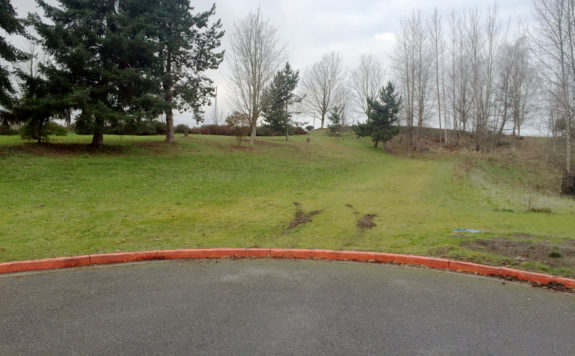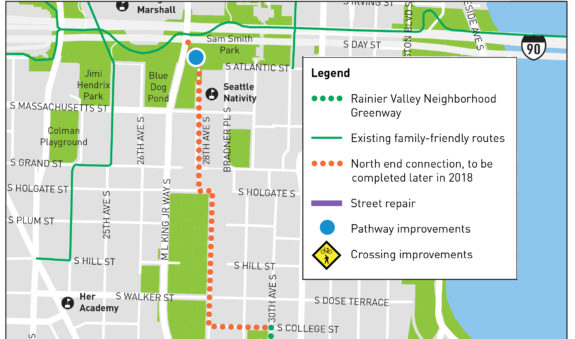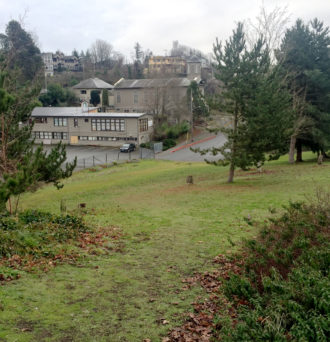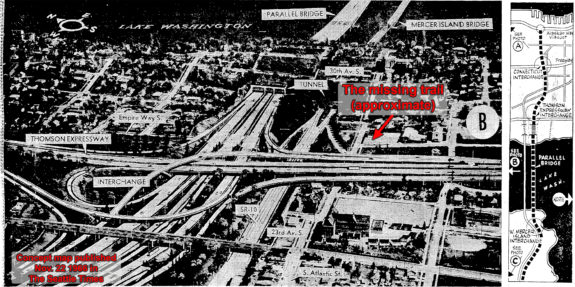
For years, WSDOT has resisted working with Seattle to connect the Rainier Valley Neighborhood Greenway to the Mountains to Sound Trail (AKA the I-90 Trail), according to reporting by Ryan Packer for the Urbanist. Packer requested emails between the two public agencies to uncover why this final connection remains incomplete years after the rest of the route opened, and his findings are extremely frustrating.
The needed connection is very short, spanning a half a block at most from where 28th Ave S abruptly ends and the regional trail just a couple hundred feet beyond. The land the path needs to travel through is already flattened down by people walking and biking across the grass, a clear sign that a pathway is needed here. Also known as “cow paths,” informal walking paths like these show transportation agencies where unmet facilities exist in the communities they serve.


This grass is part of WSDOT’s lid over I-90, which created Sam Smith Park and is home to the I-90 Trail. The I-90 Trail is a major transportation facility of regional importance that includes investments from many agencies along its route including WSDOT. The trail connects some of the state’s largest employment and residential areas. Yet Packer’s reporting shows that WSDOT has put up major road blocks for at lease half a decade to prevent SDOT from building a short trail connecting the local biking and walking network in southeast Seattle to this regional backbone.
“A set of emails obtained by The Urbanist reveal the long battle between SDOT and WSDOT to come to an agreement around use of the property,” Packer reports. “That battle has continued into 2021, when a lease agreement was on the verge of being signed between the state and the city early this year, but city staff were surprised to find that the proposed agreement would have committed SDOT to paying nearly $24,000 per year to WSDOT in perpetuity (tied to inflation) after paying to design construct the trail connection itself.”
Charging $24,000 a year to improve access to their own transportation facility is absurd, and WSDOT lawyers justified that price because the connection is not a highway project, Packer reported:
In September of 2018, WSDOT’s legal division determined that they wouldn’t be able to provide a no-cost trail lease because the trail doesn’t have anything to do with a state highway. “This segment of the [neighborhood greenway] is not adjacent to, severed by, or a part of any state highway. The trail does provide a separation of motor vehicle traffic and pedestrians from municipal streets and routes (increased safety), but not from a state highway. There is no reliever effect, joint use, highway purpose or other benefit to the state. We must pass this test before the state can issue a no consideration trail lease as a highway benefit,” Marty Stickford, Northwest Region Program Manager Supervisor at WSDOT told SDOT then.
This trail is literally on top of a state highway, and this connection would be just a block away from the I-90 bike tunnel (built as part of the freeway tunnel) that leads to the trail on the I-90 Bridge. How is this not a “highway purpose” that “benefit[s] the state?”
Really, WSDOT should be the one paying to build this trail connection since it’s their facility. The mere existence of the cow path here (the photos above are from 2016, so before the city’s neighborhood greenway was constructed) demonstrates that the state’s original lid design was incomplete and has always needed this path. But if they won’t fix their own deficient transportation infrastructure, the least they can do is allow SDOT to fix it for them without charging a big annual fee for the rest of eternity. Unlike with the state’s endless roads budget, Seattle’s bike budget does not have money to dedicate in perpetuity like this.
I guess we need someone high up to step in and end this absurdity. But beyond this one trail connection, this project highlights a larger problem with WSDOT. The department remains hostile at worst and indifferent at best to the communities their facilities travel through. Whether it’s people trying to walk across a fast and terrifying freeway on-ramp or people trying to get from their homes to a regional trail, WSDOT is consistently an impediment to street safety and non-motorized mobility. This needs to change.

Not so long ago, the people living near this missing pathway organized themselves and revolted against the state highway department’s plan to cut a deep trench through the hillside and the neighborhood, displacing many households and essentially wiping Judkins Park off the map. This neighborhood displacement was seen by many highway planners as a good thing, since many Black people lived in Judkins Park and freeways were a common tool for so-called “urban renewal” efforts that displaced Black communities across the nation. The fight, led in part by the local chapter of the Black Panthers and a young Larry Gossett, won major changes to the state’s plan including the freeway lid and the trail that runs across it. It was a tough and generally unsatisfactory compromise, but it was the best that people could get and far better than the state’s preferred plan. A lot of homes and businesses were still destroyed in the old Atlantic neighborhood and the International District when the state built I-90.
So the lid and the trail are very much a part of the state’s highway, and it is revisionist history for WSDOT to claim otherwise. The lid exists as a lasting monument to a time when the state wrongly went to political war with a neighborhood rather than working with residents to improve their community. And it seems WSDOT still has not learned the lesson of that time. They should be looking for ways to improve life for people who live near their infrastructure rather than finding excuses to block such improvements.
The typical person has no idea and does not care which government agency owns the land where they are trying to walk or bike, they just want the route to be safe and connected. It shouldn’t matter which agency owns the land because they all exist to serve the public. Seattle residents are also Washington residents. It’s absurd and embarrassing that in half a decade they cannot find a way to build a few hundred feet of pathway so that people on the city’s new bike route can reach the state’s trail.












Comments
7 responses to “WSDOT won’t work with SDOT to connect the Rainier Valley Greenway to the I-90 Trail”
Of course, the city could just go in and build the trail. But that would end up with the two agencies suing each other for hundreds of thousands of dollars.
Or the city could just turn a blind eye and let volunteers from the bicycle community build the trail and then just pull the stalling game when the state wants it removed. (Works for tent cities)
Or the bicycle community could begin disrupting Inslee’s re-election rallies until he figures it out (fat chance). No sense in protesting the mayor. She doesn’t give a sh!t about anybody but herself and she is on her way out – hopefully forever.
Or you could get Ron Sims to help out. Yea, he is getting old, but at one time he was an avid bicyclist.
There are so many possible solutions to this if WS-DOH! was only interested in improving the community.
1. WS-DOH! says it has to lease the land under the trail, lease it to SDOT for $1 a year.
2. Let WS-DOH! own the trail but Seattle pays to build it and maintain it.
3. Change the interpretation of what the trail is doing. It’s not extending the RV Greenway to the I-90 trail, it’s extending the I-90 trail to connect to the RV greenway. That way SDOT is extending the I-90 path, not building a “new” trail.
The whole lease thing is ridiculous anyway. Is the ground under the playground just east of where SDOT wants to build the trail being leased? Are the bike polo courts on the I-90 lid being leased? Is Mercer Island leasing the baseball field on their part of the lid?
Meanwhile we can’t have bike lanes on Rainier, we can’t have them on MLK south of Rainier, we can’t possibly close part of Lake Washington Boulevard to motor vehicle traffic to provide another all-ages all-abilities route east of Rainier. We might be able to get bike lanes on MLK from Rainier to the I-90 lid, but it’ll take another 3 years and you can bet your bottom dollar that everyone who opposes them will point out that there’s a greenway just a few blocks away and “why can’t those entitled elitist cyclists just use that”?
Put in a curb cut, complete the R-V greenway signage to that point. Let people continue to travel across the grass. If WS-DOH! complains, tell them Seattle will take out the curbcut and lease it to them for $24K a year.
The lease thing is very silly and demonstrates what happens when two bureaucracies butt heads, but it’s not unheard of. I know King County has dealt with this on trail projects, including properties owned by Seattle (SPU, SCL, SDOT). where they pay perpetual leases. Seattle is no more reasonable than WSDOT.
I don’t think it animosity or malice, I think it’s just public agencies taking the easy way out. Nobody gets sued or loses their job for following the rules. I think we need better direction at the state level for public agencies to share property for the common good.
Yeah, I think the added frustration here is that both SDOT and WSDOT are at least in theory supposed to be working to help people get around and both have transportation facilities that would benefit from this connection. With City Light, they aren’t a transportation agency, so some money changing makes more sense (they all have books to balance, and land is valuable).
I went into google maps to look at this and lo and behold there’s someone going cross country on a bike. https://goo.gl/maps/o98BbmhXhTmguvpx6
The city decided to put a greenway on 28th, but the existing connection to the I-90 trail is on 29th. Easy solution, move the greenway. There are bike route signs already there. If somebody really cares, give Barb Chamberlain at WSDOT a call. The lease is not her responsibility, but she can tell you who to talk to next if you want to elevate. Yeah, this is supper silly, but there is also state law that requires WSDOT to collect rent (even for bus stops in some cases), so talk to your legislature about changing that law and allowing free use for transportation purposes.
Dude, just take a look at the grades around there. 28th is a better place for the greenway. Making another connection at 28th is a simple thing that SDOT is happy to do. It’s just the lease thing that needs to be worked out. A $1/yr lease would be nice, but I imagine the state law says something about the lease needing to be fair market value.